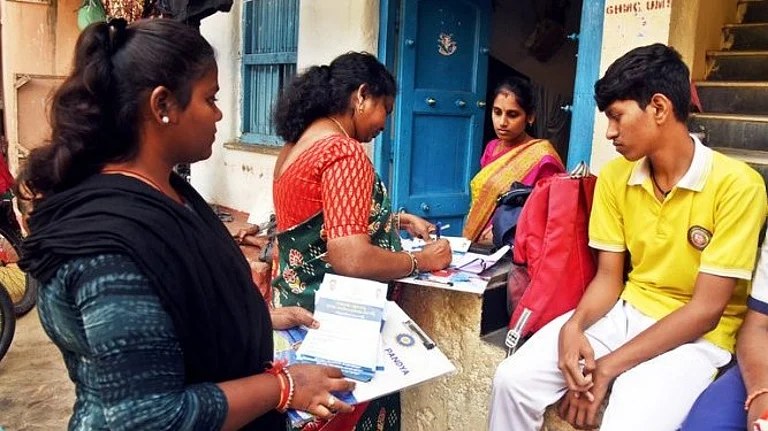IT had been projected as a veritable oasis on the desert sands of Delhi's club life. But the Rs 120-crore India Habitat Centre (IHC) is to be stripped of all "five-star frills" and may remain a mere mirage for its 6,000 individual and 130 corporate members. The turning point was the recent exit of its high profile director, Vinay Jha, following a bitter feud over the costs and scale of the project with two Governing Council (GC) members, Tata Energy Research Institute (TERI) Director R.K. Pachauri and Housing and Urban Development Corporation (HUDCO) Chairman K.K. Bhatnagar. But with the commissioning already delayed by two years, neither is willing to talk to the press.
Jha's three-year contract expired on September 30 but he was hopeful of getting an extension and the GC made no effort to find a successor. However, when the GC decided against an extension at the eleventh hour, the Tamil Nadu cadre IAS officer had to step down on October 5. Interim charge has been given to HUDCO executive director R.M.S. Liberhan, whose top priority is to make IHC 'functional' at the earliest, "minus all the needless frills and extravagance".
This is a far cry from the earlier aim to take on India International Centre (IIC), Delhi intelligentsia's most coveted watering hole. IHC was to have seven restaurants, three bars, a 650-seater auditorium, an art gallery, library, swimming pool, fitness centre and six conference halls.
The crux of the problem is a shortfall of Rs 25 crore. Insiders say that even after these funds, which are nowhere in sight, are raised, it will take "at least six months" before the club's doors are thrown open. Conceived six years ago as a "physical environment which would serve as a catalyst for a synergistic relationship between individuals and institutions working in habitat-related fields", IHC has been designed by architect Joseph Allen Stein.
Trouble began in May last year when the GC reviewed the budget and all plans and construction were put on hold for seven months. The GC was split into two distinct camps. Jha opposed the stoppage of work and wanted the bulk of the Rs 25 crore to be realised from the 26 institutional members backing the project. He claimed that the initial project estimates fell short by about Rs 25 crore, and had proposed that Rs 10 crore be generated as bank loans and the balance by raising the price of the floor space sold to institutional members.
But Pachauri and Bhatnagar, heads of the two biggest institutional members, felt that project costs had been grossly exceeded. The institutions bought space atRs 1,700 per sq ft and opposed Jha's proposal that it be raised to Rs 2,600 per sq ft. Says a GC member: "Too many individual members have been inducted. The budget has gone out of hand because of the cost of huge, five-star members' facilities with fancy interiors created by Jha. Besides, in a job requiring a 15-hour daily grind, he kept a 10 am to 5 pm schedule with a two-hour lunch break. Such slack supervision resulted in heavy cost overruns."
While there is to be no change in the number of members' facilities, Liberhan's mandate is to speed up the work and ensure tighter control. First to feel the pinch will be hotelier Rohit Khattar, whose firm Old World Hospitality, which has the contract for IHC's restaurants, had raised eyebrows by announcing that it would arrange private "theme parties" at the centre. "These chaps have to be put on a leash, for, given a chance they won't hesitate toorganise a mujra in the centre. The tail can't wag the dog," says the GC member.
The bickering doesn't end there. Architects and builders Stein, Bhalla and Doshi—who were awarded the building contract—pulled out soon after the design was finalised. Things only got worse when J.R. Bhalla took on the project, with allegations leveled that he wasn't up to a project of this magnitude (93,000 sq ft).
For his part, Stein is upset over "significant changes" made to his architectural design and says the original goal of developing a synergistic working environment for habitat-related institutions and individuals is likely to be forsaken as many institutional members have nothing to do with human habitat. Says he: "Changes have been made to accommodate large eating spaces for members in an area that was essentially meant to be a support facility for the institutions housed in the main block. Moreover, while both TERI and the Vikram Sarabhai Foundation are excellent in their respective fields, I wonder what synergism can possibly be developed between them."
Denying Stein's charge that the design was changed in any way, GC members are more caught up in the task at hand: to find a "dynamic director" who will not only manage IHC efficiently but will also have the creativity to develop synergism among the institutions housed there. Any way you look at it, there is serious trouble in this would-be paradise.






















